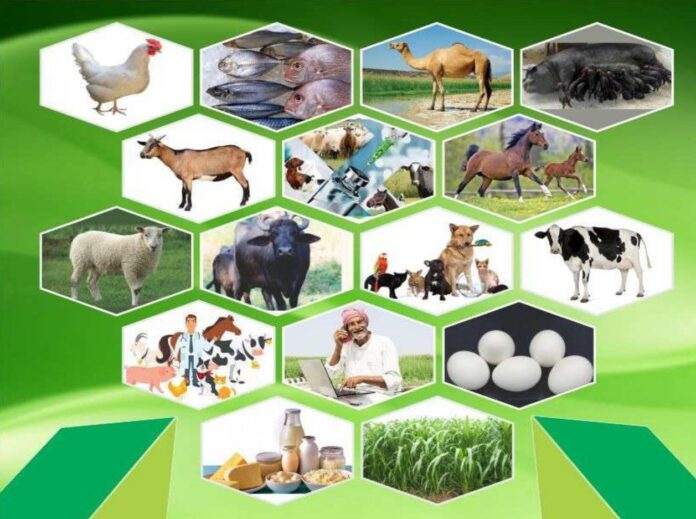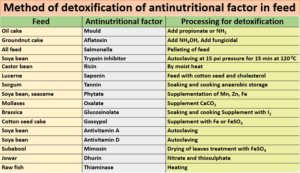Major Anti-nutritional factors in Feeds & Fodders of livestock and their Corrective Measures
Plants have developed a number of survival mechanisms to reduce the chances of their seeds being eaten or digested by insects, birds or other animals. One defense mechanism is the production of compounds called antinutrients or antinutritional factors (ANFs), which are toxic to the animals or inhibit digestion of the seeds. Health benefits to fish have not been reported. Therefore, antinutritional factors are an important consideration in animal and fish nutrition because many feed ingredients used in animal and fish feeds are produced from grains, legumes and oilseeds (Krammer et al., 1984). Two main approaches to eliminating ANFs in feed ingredients are the destruction or removal of ANFs during seed processing and changing specific genetic characteristics of the seeds. Some antinutritional factors can be destroyed or removed through certain conditions (e.g. High temperature extrusion processing of soybean or canola meal and solvent extraction of whole oilseeds or their protein rich by-products following oil extraction). Plants commonly synthesize a range of secondary metabolites as part of their protection against attack by herbivores, insects and pathogens or as a means to survive in adverse growing conditions. If farm or domestic animals or humans consume these plants, these compounds may cause adverse physiological effects. The terms antinutrient or natural toxicant have been widely employed to describe plant defense metabolites in the structures of the individual compounds, which can range from high molecular weight proteins to simple amino acids and oligosaccharides. Legumes are a rich source of antinutrients in the human diet. A number of so called antinutrients have been shown to possess beneficial- anticancer, antimicrobial- properties which also vary according to their level in the diet. Brief reference to such effects are also included because a pressing challenge to scientists is to identify optimal levels for maximizing the benefit to risk ratio, thereby providing plant breeders, molecular biologists and food processors with additional goals for maximizing overall product quality. Methods for reducing antinutrients in food are presented according to their physical (dehulling/ cooking; autoclaving/pressure cooking; dry roasting; soaking; milling/ultrafiltration) or biochemical (enzyme processing; fermentation; germination) character. Given the importance of antinutrients to the developing plant the complete removal of these compounds by breeding or biotechnological programs, even if possible, may produce plants with poorer growth and lower yield characteristics (Khokhar and Apenten, 2014; Bora, 2014). The structures of the antinutrients and their chemical properties, especially their heat lability, dictate which physical processes will most effective in their reduction or removal, thereby minimizing adverse biological effects. Plant food also contains proteinaceous antinutrientis including protease inhibitors, phytohaemagglutinins, lectins, α-amylase inhibitors and allergens. Consumption of raw legumes leads to nausea, vomiting and diarrhea. More chronic effects of protein antinutrients include pancreatitis and some from intestinal cancer although such effects have not been proven unequivocally. A number of antinutrients have been shown to possess beneficial properties for example; anticancer, antimicrobial. Such compounds are of increasing interest in the fields of biochemistry, medicine, pharmacology and nutrition (Akande, et al., 2010)
| HARMFUL NATURAL CONSTITUENTS OF FEEDS AND FODDERS |
- Harmful natural constituents are also called as anti nutritional factors.
- Anti-nutritive substanceis defined as “those generated in natural feedstuffs by the normal metabolism of the species and exerts effects contrary to optimum nutrition”.
Type of Anti-nutritive substances
- On the basis of the type of nutrient affected and the biological response produced in the animal, the toxic factors can be classified into six major groups as follows:
- Substances depressing digestion or metabolic utilization of protein:
- Protease inhibitors
- Lectins or Ricin (hemagglutinins)
- Saponins
- Polyphenolic compounds (Tannins)
- Substances reducing the solubility or interfering with the utilization of mineral elements:
- Phytic acid
- Oxalic acid
- Glucosinolates
- Gossypol
- Substances inactivating or increasing the requirements of certain vitamins and certain mineral:
- Antivitamins A, D, E, K and anti-pyridoxine
- Antiminerals such as Phytic acid, Oxalic acid etc.,
- Mimosine (Anti hormone)
- Nitrates and nitrites
- Moulds and mycotoxins in animal feedstuffs
- Substances depressing digestion or metabolic utilization of protein:
Methods of detoxification of antinutritional factor present in feed
- All feed
- Toxin: Salmonella
- Detoxification method: Pelleting of feed
- Oil cake
- Toxin: Mould
- Detoxification method: Add propionate or NH3
- Groundnut cake
- Toxin: Aflatoxin
- Detoxification method: Add NH4OH, Add fungicidal
- Soya bean
- Toxin: Trypsin inhibitor
- Detoxification method: Autoclaving at 15 psi pressure for 15 min at 120°C
- Castor bean
- Toxin: Ricin
- Detoxification method: By moist heat
- Lucerne
- Toxin: Saponin
- Detoxification method: Feed with cotton seed and cholesterol
- Sorgum
- Toxin: Tannin
- Detoxification method: Soaking and cooking anaerobic storage
- Soya bean, seasame
- Toxin: Phytate
- Detoxification method: Supplementation of Mn, Zn, Fe
- Mollases
- Toxin: Oxalate
- Detoxification method: Supplement CaCO3
- Brassica
- Toxin: Glucosinolate
- Detoxification method: Soaking and cooking Supplement with I2
- Cotton seed cake
- Toxin: Gossypol
- Detoxification method: Supplement with Fe or FeSO4
- Soya bean
- Toxin: Antivitamin A, Antivitamin D
- Detoxification method: Autoclaving
- Subabool
- Toxin: Mimosin
- Detoxification method: Drying of leaves treatment with FeSO4
- Jowar
- Toxin: Dhurin
- Detoxification method: Nitrate and thiosulphate
- Raw fish
- Toxin: Thiaminase
- Detoxification method: Heating
Anti Nutritional factors Present in Livestock Feedstuffs
Anti Nutritional factors in Feedstuffs1
DR S.SELVAKUMAR,ANIMAL NUTRITIONIST,CHENNAI





